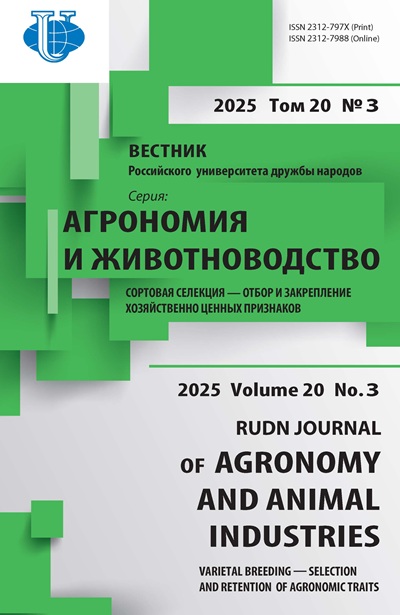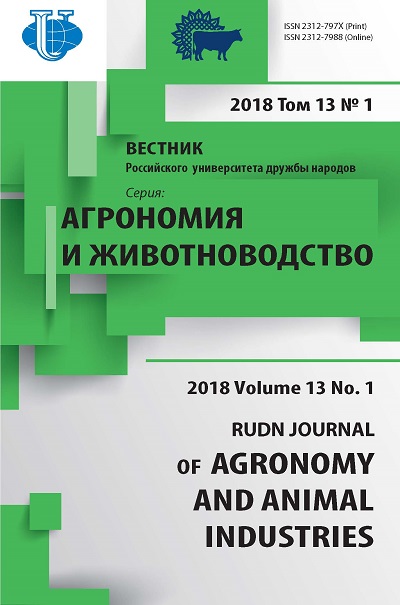Изучение морфологических и биохимических показателей растений Amaranthus tricolor L. сорта Валентина
- Авторы: Платонова С.Ю.1, Пэлий А.Ф.1, Гинс Е.М.1, Соболев Р.В.1, Введенский В.В.1
-
Учреждения:
- Российский университет дружбы народов
- Выпуск: Том 13, № 1 (2018)
- Страницы: 7-13
- Раздел: Растениеводство
- URL: https://agrojournal.rudn.ru/agronomy/article/view/18078
- DOI: https://doi.org/10.22363/2312-797X-2018-13-1-7-13
- ID: 18078
Цитировать
Полный текст
Аннотация
Изучали морфометрические и биохимические показатели красноокрашенного растения Amaranthus tricolor L. сорта Валентина, проведено определение содержания восстановленной формы витамина С, пигмента амарантина в корнях, листьях, стеблях и соцветиях. Исследования показали наличие высокой концентрации витамина С в листьях амаранта как в открытом грунте (195 мг %), так и в пленочной теплице (176 мг %). В листьях амаранта разных сортов вида Amaranthus tricolor в большом количестве накапливается вторичное соединение - антиоксидант - амарантин. Красно-фиолетовая окраска листьев обусловлена наличием в вегетативных органах растения красно-фиолетового пигмента - амарантина. Важно отметить, что у сорта амаранта сорта обнаружены вещества с антиоксидантной активностью: аскорбиновая кислота, селен, каратиноиды, метионин. В наибольшем количестве амарантин находится в соцветиях (2,18 мг/г) и листьях (1,41 мг/г). Его предшественниками являются D-глюкоза и L-тирозин - фотосинтетические метаболиты, которые используются в ростовых процессах и в биосинтезе амарантина. В красноокрашенных растениях рода Amaranthus бетацианин - амарантин представляет собой 5-О-глюкуронидоглюкозид бетанидина. Листья с повышенным содержанием красно-фиолетового пигмента амарантина используют при производстве пищевых добавок-красителей Амвита и Амфикра, применяемых в пищеконцентратной промышленности. Эти добавки благодаря антиокислительным свойствам способствуют повышению иммунитета и обладают иммуномодулирующей активностью. Экстракция листьев амаранта в H2O выявила высокие показатели антиоксидантной активности (ССА от 1,81 мг экв ГК/г). Низкое содержание глютена делает амарант чрезвычайно ценным и полезным продуктом для функционального питания.
Ключевые слова
Об авторах
Светлана Юрьевна Платонова
Российский университет дружбы народов
Автор, ответственный за переписку.
Email: Svetlana.Platonova.00@mail.ru
аспирант агробиотехнологического департамента Аграрно-технологического института Российского университета дружбы народов
ул. Миклухо-Маклая 6, Москва, Россия, 117198Александр Федорович Пэлий
Российский университет дружбы народов
Email: kaluga-peliy@yandex.ru
аспирант агробиотехнологического департамента Аграрно-технологического института Российского университета дружбы народов
ул. Миклухо-Маклая 6, Москва, Россия, 117198Екатерина Муратовна Гинс
Российский университет дружбы народов
Email: Katya.888888@yandex.ru
магистрант агробиотехнологического департамента Аграрно-технологического института Российского университета дружбы народов
ул. Миклухо-Маклая 6, Москва, Россия, 117198Роман Владимирович Соболев
Российский университет дружбы народов
Email: maestro1994liveru@mail.ru
магистрант агробиотехнологического департамента Аграрно-технологического института Российского университета дружбы народов
ул. Миклухо-Маклая 6, Москва, Россия, 117198Валентин Валентинович Введенский
Российский университет дружбы народов
Email: vaval-ved@yandex.ru
кандидат сельскохозяйственных наук, доцент, директор агробиотехнологического департамента Аграрно-технологического института Российского университета дружбы народов
ул. Миклухо-Маклая 6, Москва, Россия, 117198Список литературы
- Кононков П.Ф., Гинс В.К., Гинс М.С. Амарант перспективная культура XXI века. М.: Изд-во Российского университета дружбы народов. 1999.
- Кононков П.Ф., Пивоваров В.Ф., Гинс М.С., Гинс В.К. Интродукция и селекция овощных культур для создания нового поколения продуктов функционального действия. М.: Российский университет дружбы народов. 2008.
- Шафигуллин Д.Р., Пивоваров В.Ф., Гинс М.С. Особенности вариаций признаков скороспелости у овощных и зерновых форм сои // Российская сельскохозяйственная наука. 2017. № 5. С. 18-24.
- Шафигуллин Д.Р., Гинс М.С., Романова Е.В., Бородин Д.Б. Изучение скороспелости у коллекционного материала сои // Вестник Орловского государственного аграрного университета. 2017. № 3 (66). C. 56-62.
- Кононков П.Ф., Гинс В.К., Пивоваров В.Ф., Гинс М.С., Бунин М.С., Мешков А.В., Терехова В.И. Овощи как продукт функционального питания. М.: Столичная типография. 2008.
- Высочина Г.И. Амарант (Amaranthus L.) химический состав и перспективы использования // Химия растительного сырья. 2013. №2.C.5-14.
- Каpаваев В.А., Гунаp Л.Э., Мякиньков А.Г., Гинc М.C., Глазунова C.А., Левыкина И.П., Лепешкин Ф.Д. Медленная индукция флуоресценции и продуктивность ячменя, обработанного cверхкритическим флюидным экстрактом амаранта // Биофизика. 2012. Т. 57. № 4. С. 662-664.
- Байков А.А., Гунар Л.Э., Гинс М.С., Глазунова С.А., Караваев В.А., Левыкина И.П. Фотосинтетическая активность и продуктивность ячменя, обработанного сверхкритическим флюидным экстрактом амаранта // В сборнике: Роль физиологии и биохимии в интродукции и селекции овощных, плодово-ягодных и лекарственных растений. Москва. 2011. С. 13-15.
- Гинс В.К., Пиункова С.А., Коничев А.С., Гинс М.С., Пивоваров В.Ф., Байков А.А., Горбатовская Е.А., Романова Е.В., Кузнецова Л.В. Инсектицидное действие метаболитов экстрактов амаранта // Новые и нетрадиционные растения и перспективы их использования. 2016. № 12. С. 191-195.
- Гинс М.С., Харченко В.А., Гинс В.К., Байков А.А., Кононков П.Ф., Ушакова И.Т. Антиоксидантные характеристики зеленных и пряно-ароматических культур // Овощи России. 2014. № 2 (23). С. 42-45.
- Мамедов М.И., Пышная О.Н., Байков А.А., Пивоваров В.Ф., Джос Е.А., Матюкина А.А., Гинс М.С. Состав антиоксидантов в плодах Capsicum spp. для получения биофортифицированной продукции // Сельскохозяйственная биология. 2017. Т. 52. № 5. С. 1021-1029.
- Сапожникова Е.В., Дорофеева Л.С. Определение содержания аскорбиновой кислоты в окрашенных растительных экстрактах йодометрическим методом // Консервная и овощесушильная промышленность. 1966. № 5. C. 29-31.
- Гинс М.С., Пивоваров В.Ф., Гинс В.К., Байков А.А., Платонова С.Ю., Гинс Е.М. Содержание и пигментный состав автотрофной и гетеротрофной ткани листьев амаранта вида A. tricolor L. // Овощи России. 2016. № 3 (32). С. 79-83.
- Гинс М.С. Биологически активные вещества амаранта // М.: Российский университет дружбы народов. 2002.
- Khandaker L., Ali M. B., Oba S. Общая активность полифенолов и антиоксидантов красного амаранта (Amaranthus tricolor L.) под воздействием солнечного света // Журнал Японского общества садоводческой науки. 2008.
Дополнительные файлы















